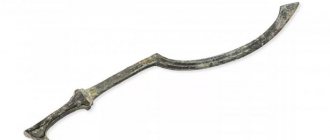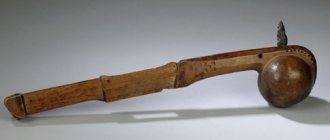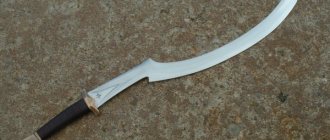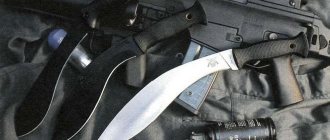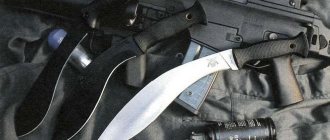- DESCRIPTION
- TYPES AND METHODS OF USING POLE WEAPONS
- WEAPONS USED IN ANCIENT CHINA
- ESPOTON
- SLAVIC WEAPONS
- SULITSA
- ROHATYNA
- OWL
- BERDYSH
- PARTISAN
- HALBERD
- THROWING WEAPON-PILUM
- JAPANESE WEAPONS
- YARI
- HOKO
- NAGINATA
- GLEFA
- SARISA
- PEAK
- TRIDENT
- TOMAHAWK
- WAR HAMMERS
- SPEARS
- In conclusion about polearms
Description
In this report we will consider the topic of medieval weapons, namely polearms.
This type of weapon belongs to the cold weapon subtype and was widely used in the Middle Ages. Let's study their most common types. Let us trace the path of their modernization from the time of invention to the present. Let's look at the strongest and weakest points. Let's look at weapons for women. The design of the weapon is as follows: the warhead of the weapon is attached to a long stick. The long handle is called the shaft.
Polearms were typically made of wood. The modified shaft could have various combat metal parts on it, which served to cause damage and also increased the strength of the weapon.
Pole weapons became widespread in ancient times. It is generally accepted that initially it was an ordinary stick, without any additions. Initially, the use of such bladed weapons was widespread only in hunting. There are a huge number of types of this bladed weapon, this is due to the rapid development and spread of this type of weapon, due to the ease of its creation. This article will look at some types of impact weapons, battle axes.
Battle axes are also usually classified as short-shafted weapons.
Almost polearm[edit]
Types of weapons with shafts that are too short to be considered a true polearm and too long to be considered a non-polepole:
- Alshpis - a Swiss stump of a pike with a short shaft, which was used as a two-handed spear
- Dadao - Chinese, either a glaive with a very short hilt, or a two-handed sword with a very long hilt
- Maquila - Basque light short spear used for fencing like a sword
- Nagamaki - Japanese, either a glaive with a very short hilt, or a two-handed sword with a very long hilt
- Rochin is an Okinawan short spear used for fencing as a sword paired with a fist shield. Obviously comes from a sword that looked like a Chinese version of a falchon (or broadsword) known as dao, since such a sword is also called the same word. But then, during the Japanese conquest of Okinawa, the Japanese banned all swords for the Okinawans, and the Okinawans replaced the sword with a short spear.
TYPES AND METHODS OF USING POLE WEAPONS
Polearm weapon
Pole bladed weapons were made either from wood or from bamboo (in Asia). The standard type had a round or oval rod. In Russia, in different regions the name was different and had the form: ratovishche, iskepische and struzhie.
Also, such weapons could additionally have stripes made of metal. They had a protective function and reduced the risk of being cut by the enemy to a minimum. Also, to perform these same functions, the shaft could be shackled. The place of existence of other modifications has also been confirmed: the addition of loops to the shaft into which hands were placed, and various types of winding. The most modified polearm was considered to be one with spikes. It reduced the chances of the weapon being captured by the enemy.
Such weapons were divided into several types, depending on the length of the handle (shaft):
- up to one hundred and twenty centimeters in size - short-shafted;
- ranging in size from one hundred twenty to one hundred and fifty centimeters - middle river;
- the longest weapon was from two hundred and fifty centimeters in size - long-shafted.
Taking into account the length of the weapon, the method in which the tip is attached is selected. The tip was secured most often using a shank or sleeve. It could also be attached through a special hole, after which it was firmly fixed.
To fix it in the ground, an additional small tip was often installed. The additional tip could also be used to inflict maximum damage.
It is also customary to use it when making flags and similar things.
Polar "half-breeds"
And now let’s move on to “half-bloods” - derivatives of spades and spears, the numbers of which are too many to count, but worth understanding. The main feature of such weapons is the desire to increase the combat capabilities of an ordinary spear. Note, increase, but not replace. However, you will soon see this for yourself.
Spetum
A "classical" attempt to improve the offensive and defensive properties of the spear, also known as "corseca". It is a spear with a long sharp tip, at the base of which, at an angle of approximately 45 degrees to the main tip, two additional petals diverge in the form of slightly curved hooks. Such a weapon inflicts much more serious lacerations in an attack, and allows you not only to stab, but also to chop the enemy. In defense, there is a serious chance not only to parry, but also to capture the enemy’s weapon between the “petals”, and also to more effectively keep the enemy at a distance.
Partisan
At first glance, the protazan looks like a type of spetum (or spetum - protazan), however, these two types of weapons are very different in fighting style. If a spetum is a spear with the ability to cut with it like an ax due to additional “petals,” then a protazan is more like something like a sword (double-bladed blade) with a long handle, which can, if necessary, stab like a spear.
The “petals” of the blade on the main blade are fixed much lower and are usually directed to the sides. The design of the tip allows you to first parry and block the enemy’s weapon, and then, by turning the handle, throw it to the side, and immediately attack the defenseless enemy.
Like spethum, protazan is a purely infantry weapon, and, moreover, quite late. As a rule, they are not found among peoples who have not yet gone through the “classical” Middle Ages.
Polex
If you simply take and fold a spear and an ax, you will not get a halberd at all, as many people think, but a polex. Actually, the weapon looks exactly like an ordinary spear with an ax blade attached to the tip. Polex was almost never taller than a man, and well combined the advantages of both types of weapons mentioned above. The weapon is purely infantry, and very beloved by tournament fighters at the turn of the 15th and 16th centuries.
Halberd
Compared to the poleax, the halberd is somewhat longer (up to 2.5 meters), its sharper is always needle-shaped, the ax blade is narrow, made integral with a spear tip, and on the back side, as a rule, is equipped with a hook curved down. Both the ax and the hook tried to make the impact area as small as possible in order to maximize its strength.
The weapon turned out to be truly terrible in battle and truly universal. The tip pierced any armor without any problems, and the blade and butt of the ax inflicted terrible cutting wounds; the hook on the butt was very convenient for piercing armor or pulling opponents off horses and fortifications. Shorter, “boarding” options were successfully used in naval battles, not only directly in the battle, but also to attract opposing ships to each other during boarding.
There were a great variety of halberds, differing in the length and shape of the ax and tip.
Berdysh
If you attach a wide, crescent-shaped ax blade to a shaft about 1.5 meters long, you will get a reed. True, the fastening must be special: the blade of the reed (unlike the ax) is attached to the shaft not only by the butt, but also by the braid - the lower “shoot” of the blade. Berdysh is primarily a chopping weapon, however, using the sharp upper edge of the axe, it can be used to stab like a spear. Due to its weight, wide blade and small size, the reed allows you to inflict very serious wounds, very effectively defend against blows, and, unlike most other types of polearms, is useful even in close melee combat. The lower part of the reed's shaft was equipped with a sharp metal rod, with which the weapon could be stuck into the ground and used as a stand for early firearms.
Voulge
A vulge is a hefty cleaver, in the upper part it turns into a spike or hook, attached to the shaft through a butt, in the manner of an ax. The length of this weapon miracle is approximately 1.8-2.3 meters; structurally, it represents a transitional link between an ax and a halberd. Thanks to the massive blade and rather long shaft, the blow of the vulge can easily cut through heavy armor. Like the berdysh, this is a simple and cheap weapon, which in skillful hands turns into a powerful offensive weapon. Yes, it is worth mentioning separately that this weapon is intended specifically for attack, naturally from a running start and a wide swing.
Lochaber ax
What if you take a reed, make its blade straighter, the cutting edge wavy, and attach a hook to the butt (well, or lengthen the vulge blade and shorten the shaft)? The result is a very peculiar example of medieval Scottish weaponry, known as a lochaberaxt. As in the case of the reed, it was excellent for powerful slashing blows, could be used as a piercing weapon, and, if necessary, coped well even with the enemy’s heavy cavalry.
Fauchard (or mower)
A halberd for the poor - a “mower” (or cleaver) is a blade of an ordinary peasant scythe (a sickle, and sometimes a knife) attached to the shaft vertically, like the tip of a spear. Peasants were massively armed with such weapons during wars - both “real” and partisan ones. According to contemporaries, the weapon was scary in appearance, but was not particularly effective in battle.
Although craftsmen made “fauchards” even with a hook for pulling riders off a horse, or articulated with a pitchfork, they never took root as a “serious” weapon.
Glaive
A wide blade (single-blade) sharpened only on one side, mounted using a sleeve (and not through a butt, like an axe, reed or vulge) onto the shaft. A glaive is a chopping weapon that can be used to stab like a spear; sometimes on the back of the blade there is a “petal” hook for fighting enemy cavalry. Like a spear and a halberd, a “glaive” is not a specific type of weapon, but a whole class of weapons of a similar fighting method and appearance, including the owl, naginata, bhuj, batas, palm, etc.
This weapon, simple in its manufacturing technique and methods of use in battle, was very widespread and was used not only as a combat weapon, but also as a hunting weapon. Like spears, depending on the technique of execution, glaives of different nations can differ from each other in the length of the blade and shaft.
Guizarma
The next step in the evolution of the haymaker and glaive was the guizarma. In shape, it resembles a hook with a sharpened inner side of the blade, mounted on the shaft using a sleeve. The weapon, like its “ancestors,” was simple and cheap, and therefore became very widespread. Because of this, different types of guizarms can vary greatly in weight, size, appearance and even method of application. Some of them are equipped with a long, thin bayonet-shaped tip (sometimes more than one!), which can be used for injections. Some have only a hook and can only be used for slashing, especially effective at cutting through the tendons of horses' legs.
English bill
The English “relative” of the guisarma (sometimes called the “Italian bill”) was called the “English bill” or “bill hook”. It is distinguished by a wider, sometimes wavy blade, and, usually, the absence of a pronounced straight tip like a spear. It is almost impossible to stab with an English bill, but chopping blows due to the wide “broken” blade almost always inflict fatal wounds.
Combat pitchfork
Combat pitchforks don't have much in common with peasant pitchforks. Firstly, they most often have 2 teeth (and if there are three, guess what such a weapon is called?), secondly, both of these teeth can be sharpened along the entire length, so a warrior armed with such a “slingshot” can not only to stab, but also to deliver cutting blows. Naturally, in terms of armor-piercing power, combat pitchforks are much inferior to halberds and it is difficult to penetrate heavy armor with them. But, compared to a pike or spear, they make it much more effective to keep the enemy at a distance and fight with cavalry.
However, these shortcomings were known, which gave birth to absolutely fantastic weapon monsters, like a battlefork crossed with a halberd or a polex - I don’t know about their effectiveness, but they look like you don’t want to mess with their owner at all.
WEAPONS USED IN ANCIENT CHINA
The main weapons in China in ancient times were large combat sabers (combat sword). Such weapons borrowed the best qualities from various types of combat weapons such as: sword, axes, circle, poles, spear. If you translate the name of the weapon from old Chinese, it will look like this: At the beginning, the guan dao was used as a chopping weapon; it was used only for chopping blows delivered in a vertical manner. Over time, the methods of causing damage have expanded dramatically. The peak use of weapons occurred during the Northern and Southern dynasties, respectively.
The blade is most famous in Japan, Korea and Vietnam.
The length of the blade could reach from seventeen to seventy centimeters. It also had a curved blade. This weapon had a modification in the form of a spike-piercer on the butt of the wavy-shaped blade. It was necessary when parrying attacks inflicted by the enemy.
The production of this type of blade was carried out using three layers of steel.
The average weight of such a weapon could reach two kilograms.
Best Maces in Valheim
The mace is considered a cross between a sword and a sledgehammer. It reduces the speed of movement much less, but it can stun and parry a blow well. Another decent weapon option for a universal build in Valheim.
Silver Mace
One of the best weapons. Has elemental damage (ice and cold) , which fully compensates for the lack of an additional attack. Damage indicators can be improved by upgrading the “club” skill. Thanks to it, mastery of 2 more types of hand weapons is improved: clubs and sledgehammers.
For production you need:
- ancient bark (x10)
- silver (x30)
- flesh of ymir (x5)
- frost gland (x5)
We extract iron from dragons in the Mountains.
Repair Rack Level: 3
Porcupine
The best mace in Valheim. Monsters and opponents have a very low chance of surviving an additional Porcupine attack. Perfect for battles of any complexity and type: both for PvP battles and for meeting the inhabitants of Valheim. The only thing is that it is very difficult to craft this mace.
For production you need:
- quality wood (x5)
- iron (x20)
- needle (x5)
- linen thread (x3)
Repair Rack Level: 4
SLAVIC WEAPONS
SPEAR OF SULIC
Sulitsa is a variant of the Slavic spear. Its dimensions did not reach the size of a standard spear, but it was larger than a bow arrow. Such spears had a wide range of shapes, ranging from diamond to conical.
According to archaeological finds, the length of one such spear was about a meter. It was also customary to collect them in a heap, forming so-called quivers.
The sulitsa was used only in the initial stages of the battle. In terms of combat effectiveness, it can be compared to a heavy dart. It found its application among horsemen and infantry.
ROHATYNA
It is a Russian invention. The average weight of such a weapon is one kilogram, the tip ranged in size from thirty to seventy centimeters.
This type of equipment found its use when hunting large species of animals, as well as in battle when defending against horsemen. Over time, it was replaced with more effective peaks.
OWL
Sovnya
Sovnya is the peaceful prototype of the glaive. It consists of a shaft and a blade with one blade mounted on it vertically. They began to use it as one of the types of weapons due to the lack of better weapon options.
The first mention appears in the twelfth century. Although it was not particularly distinguished by its quality, it became widespread during the period of struggle with the Poles and Swedes. The material at that time was very cheap, and manufacturing did not cause any difficulties. However, by the seventeenth century, the quality of the material improved, allowing it to be used in officer circles.
BERDYSH
Berdysh
Berdysh is a piercing and cutting weapon. Its appearance is recorded around the fifteenth century. It has a long shaft. In terms of universal properties, it surpassed the ax and pike. Used by guards and shooting troops. If necessary, it could be used instead of a stand.
It was inexpensive and easy to use. In connection with these properties, a decree was issued on the storage of berdysh among peasants.
The Polish version of the berdysh had smaller dimensions, up to 1.2 meters, and weighing from two to three kilograms.
Reduced modifications were used in service with horsemen and mounted archers.
Polar "cousins"
These examples of medieval weapons are so far removed from their ancestors that, perhaps, only the presence of a shaft makes them similar to their ancestors.
Lucerne hammer
It is very similar in appearance to a halberd, but the spike-hook (or hammer) on the butt is usually larger in size and bent down, and the ax handle is replaced by a hammer head. The firing pin is very narrow and, as a rule, not flat, but made in the form of three or four teeth to prevent slipping upon impact. Thanks to its small impact surface and strong swing, the Lucerne hammer is capable of punching holes in any armor. Compared to the halberd, the Lucerne hammer is somewhat less effective, because its firing pin plunges into the entire length of the enemy’s body and, as a result, can become firmly stuck and temporarily disarm its owner. On the other hand, if a halberd can slip off an enemy’s shield or helmet with an oblique blow, the Lucerne hammer does not have this drawback - if a hit occurs, then this hit is guaranteed to inflict a mortal wound on the enemy.
The length of the Lucen hammer reaches 2 meters.
Klevets (minted, bec de corbin)
Mistakenly called a “reed,” this version of the Lucerne hammer is distinguished by a “spear” tip (but more often without it at all), a wider striker and the replacement of the hook blade on the butt with a second striker, but not serrated, but sharp. The Bec de Corbin is shorter and more suitable for hand-to-hand combat, and also, unlike the Lutzernhammer, can be used as a non-combatant weapon, but as an individual weapon.
The following samples are classified by different classifications as either one or another “parental” type. To avoid creating confusion, I give their names separated by a dash.
Mower-guizarma
“Mutant”, combining the properties of a mower and a guizarma - from the first the shape of the blade was inherited, from the second - a hook on the butt sharpened on the inside.
Glaive Guizarma
Another attempt to create a universal weapon by combining two “specialists”. The blade of the glaive has become more massive, and the already familiar hook is attached to the butt. The result of the work was a good replacement for a halberd - inferior in efficiency, but widespread and easy to use.
Guizarme-Voulge
Again a “station wagon”, bristling with blades in all directions. The Vulge blade is complemented by a grappling hook, giving it a full range of capabilities - from slashing and piercing blows to the ability to effectively fight cavalry.
HALBERD
Halberd
It is considered one of the legendary weapons. This type of weapon was invented in the thirteenth century. The design was very simple: they took a spear and attached an ax and a hook to it. The halberd was primarily used by infantry. Her weight varied from 2.5 to 6 kilograms. There were many different modifications of the halberd, ranging from different forms of an ax to types of hooks.
Such piercing and cutting weapons gained the greatest popularity in the fifteenth and sixteenth centuries among the mercenaries of Italy and Switzerland. It was used in land and sea battles.
Such piercing and cutting weapons had high performance in battle, and could easily pierce the enemy’s armor and pull him off his horse. However, it is worth noting that there were better piercing and cutting weapons than the halberd.
In 1605 it was first noticed in Russia, and in 1856 it was banned for use. It is still used in the Vatican to this day for various ceremonies.
Spears[edit]
(link)
sparring: spearman against three swordsmen (watch from 2:17)
- Since the Bronze Age, the spear has been the main weapon of all mass infantry from the Sumerian phalanx, to the classical phalangite of Hellas and the Roman legionnaires with pilums. The same army could have up to a dozen different types of spears in service.
- In the Scandinavian sagas there are many examples of how a foot warrior went into battle with a spear in order to hit infantrymen with it. But we are again talking about a non-classical, shortened spear, like a spear (see the next paragraph). Continental Germans have been armed with a similar spear since Julius Caesar. Its Frankish variety was called frameya.
- In Europe, both cavalry and infantry of the Renaissance used pikes, as both had a critical need for armor penetration against heavy cavalry.
- In the Polish-Lithuanian Commonwealth, mounted Cossacks periodically used spears, but then from the end of the 16th century they switched to pikes, but the Lithuanian Circassians of Pyatigorsk did not abandon the spears.
- In China, the spear has three names for three types of spears, differing not in anything but in the material and flexibility of the shaft: shu (杸 shū) - a bamboo spear, very light and durable, but compared to other types of spears it is considered more fragile and capable of cracking , if you apply a spear with a swing like a stick. For Southern and Central China - the cheapest and most accessible spear (you don’t even have to attach a tip, but simply cut the bamboo obliquely). But, in those parts of Northern China where bamboo does not grow due to the climate, it is exotic.
- qiang (枪 qiāng) - a spear with a hard, inflexible spear, which can be used to deliver a ramming blow at full gallop, because this particular spear was very loved in the cavalry.
- mao (矛 máo) - a spear with a flexible, strong shaft that can be used to strike with a swing, and when thrust, it can wriggle in waves; it is with this spear that people like to show miracles of fencing.
Very short spears:
- The maquila is a Basque weapon, something between a cane and a short spear, 100-140 cm long (on average 120 cm), which allowed an impoverished, declassed fencer to fence with it like a sword and confront an enemy with a real sword.
- Rohin - a very short spear was used in Okinawa, which was formally considered an "independent" state until the 19th century, along with a sword-style shield. The reason for its appearance is the Japanese ban on Okinawans having bladed weapons. What is significant is that the Okinawans could also use the same word “rohin” to call a very long cleaver. And apparently, at one time it was quite a sword, like the Chinese w: dao, but after the Japanese ban on swords, this name was transferred to a very short spear.
THROWING WEAPON - PILUM
Pilum
Initially used in the Roman guard, and after some time in all legions.
This type of weapon was a spear with a steel or iron tip attached to it. The pilum was long in size, reaching two meters.
It was common practice to use two pilums simultaneously. They were launched at the enemy, after he was wounded, finishing off them in close combat. In most battles it was used as a secondary weapon, and only in the battle of 1948 BC it was used as the main one, which allowed Caesar to win and gain the status of dictator.
Best Swords in Valheim
The sword is an incredibly versatile weapon. It weighs a little, has average knockback, and only slightly reduces movement speed. If you have not yet found your unique way of fighting, we recommend using this particular weapon.
Silver sword
In its normal state, a silver sword is even better than its black metal counterpart, as it has additional spirit damage. It is an effective weapon and relatively easy to manufacture - the stance level should be only 3.
For production you need:
- wood (x2)
- silver (x40)
- leather scraps (x3)
- iron (x5)
Wood is obtained from gradedwarf corpses and cutting down trees. Silver is found in the Mountains. To find it you will need a Bow (drops from the Mass of Bones).
Repair Rack Level: 3
Black metal sword
Once fully upgraded, this is the best sword in Valheim . To craft, you will need to obtain ferrous metal and master level 4 blacksmithing. For these reasons, you can forget about this weapon for most of the game.
For production you need:
- quality wood (x2)
- black metal (x20)
- linen thread (x5)
Repair Rack Level: 4
JAPANESE WEAPONS
YARI
Yari
Yari piercing weapon. It has the appearance of a shaft complemented by sharpening of the blade on both sides. The time of its appearance is considered to be approximately the fifteenth century. Such piercing weapons existed in two versions: having one bladed blade; having a blade blade in two copies with different sizes. There was also protection for the hands in the form of a guard.
Yari with one blade was called katakamayari, two bladed, compared to protazan.
HOKO
Hoko
It is considered the most ancient of Japanese weapons. It can't be called very long. The size is only twenty-five centimeters. Has an iron tip or hook. Used during cavalry attacks. The beginning of use is considered to be the twelfth or thirteenth century. It was considered relatively long. The dimensions of the metal blade range from fifteen centimeters to one meter. Hoko is a piercing and cutting weapon.
NAGINATA
Naginata
The same applies to Japanese weapons. The date of creation is considered to be 782-1184. There were no size restrictions. It all depended on the owner and his preferences. It was a chopping and cutting tool. Naginatas were used by both women and men.
However, it was believed that this was a female weapon. The reasons for this opinion are the ability to contain the enemy at a certain distance, which makes all his physical advantages useless. The best example of the use of military weapons by a girl is considered to be the use of samurai girls. From 1603 to 1868, this type of weapon finally lost its popularity among men, and was “conquered” by the samurai. Often the naginata was left to daughters as a dowry, which was very honorable. However, samurai were very rare on the battlefield. Such women only defended their own homes.
"Pureblood" polearms
A spear
In fact, “spear” is the most general term you can think of. In general, this is a stick no taller (or slightly taller) than a person's height, with a dagger-shaped metal tip, no more than an elbow in length, used for piercing attacks. However, some spears can be used as throwing weapons, some (with a wide tip, like the so-called “ox tongue”) can not only stab, but also chop, and some (such simple examples as a spear) may not even have any tip, except for the hewn and burnt tip. Spears were used primarily by infantrymen.
Knight's spear
Also known as a “lance”, such a spear is longer than an “infantry” one (up to 3.5 meters), stronger, thicker, and its tip is more reminiscent of a bayonet rather than a dagger blade (although there were also wide “chopping” tips). It was used not only by knights, but also by equestrian warriors in general. It is almost impossible to encounter a knight's spear in the hands of an infantryman.
Pike
The infantry pike is a long (up to 5 meters, and varieties - for example, sarissa, up to 11 meters, so it even had to be equipped with a counterweight!), piercing weapon, much heavier (up to 4 kg) compared to the spear. The main purpose of the pike is to stop a cavalry “lava,” a massive attack by heavily armed cavalry. For this reason, the infantry pike has a “bayonet” tip. The same fact suggests that the pike, at least its infantry version, is a purely combat weapon - using it by a lone warrior is a disastrous proposition. The true power of pikes and pikemen is manifested in dense formations, which allows, due to the long length of the weapon, to create a literal wall of sharp tips that reliably keeps almost any enemy at a distance.
Length is also a disadvantage of the pike, making its owner difficult to maneuver. This was used by specially trained squads of “stormtroopers”, armed with heavy two-handed swords, which flew into the formation of pikemen and simply cut off the long shafts with powerful blows. For this reason, the shaft of the pike below the tip was usually reinforced with metal strips and plates.
GLEFA
Glaive with a spike
The glaive is a slashing, piercing and cutting weapon. Used in Italian, Burgundian, and Saxon infantry. It was considered a universal weapon. It is customary to strike from top to bottom. It was both attacking and defensive.
There was a modification in which the glaive was equipped with additional damaging elements. The design of the glaive made it possible for its owner to disarm the enemy in a short period of time. There was also a place for a two-blade glaive, but it was not very practical in use.
This piercing weapon had a huge number of modifications to its tips. And if the base (shaft) received damage in battle, then the tip was quite a threat. There were also modifications with protective properties. So one of them had a spike on the tips, which made it possible to repel attacks from above. The disadvantages include the large size of the weapon, which made it easy for the enemy to disarm such a warrior.
In our time, the glaive remains in service with the Vatican Guards.
Best sledgehammers in Valheim
The sledgehammer is a weapon for those who want to become like the gods. Incredible knockback power, high stun chance and high damage. At the same time, you can’t run fast with such things, so carefully watch your opponents’ attacks.
Reindeer
Suitable for the initial stages of the game. The crafting blueprint can be obtained after defeating Eiktur (the first boss of Valheim). The Reindeer is an excellent weapon for exploring dungeons and mines. For the player it will be the first sledgehammer in his adventures. This is a slow weapon in terms of attack speed, so the advantage in battle is achieved through the area of damage.
For production you need:
- solid wood (x20)
- deer trophy (x5)
- leather scraps (x2)
Solid wood is cut from pine trees. Scraps are obtained from the structures of goblins and boars.
Repair Rack Level: 2
Iron sledgehammer
Has the highest knockback rate in Valheim. It also deals damage over a huge area, which is ideal for fighting a group of enemies. Slow in attack speed. Like any sledgehammer, it gives a huge penalty to the character’s movement.
For production you need:
- ancient bark (x10)
- iron (x30)
- flesh of ymir (x4)
- elite trophy from drauga (x1)
Bark is obtained from trees in the Swamp. Iron is made in the Smelter from scrap metal. It also gathers in the Swamps. We buy flesh from the merchant Haldor, who does business in the Black Forest.
Repair Rack Level: 2
PEAK
Pike
The pike was a weapon that served a defensive function. Used by infantry in defense against cavalry. In very rare cases, its use against infantry has been observed. The appearance of the pike was noticed around the twelfth century among the Scots. In the fifteenth century, this type of weapon was adopted by the Germans and the Swiss.
It reaches quite a long length, exceeding the size of a spear. The damage was done by the blade. The average weight varied from four to five kilograms. With the advent of firearms, the pike lost its relevance. But in rare cases, equipping troops with a pike can be traced back to the Second World War.
TRIDENT
Trident
It is considered the most mythical weapon. It was customary to represent the two most important Roman gods with him: Jupiter and Poseidon. It was also considered a weapon for gladiator combat. It was used in fights reaching the highest cruelty.
At one time among such peoples as the Persians, and at another among the Turks and Huns, Slavs, Indians, and Germans, it was a weapon that seemed to them to give powerful advantages. In Ukraine and Mongolia, to this day it is possible to notice illustrations of the trident in various state paraphernalia.
The trident is a more developed type of spear connected to a hook. Initially it was a fishing tackle, with a blade. They slaughtered fish or various sea creatures with it.
The trident is a type of weapon used in Chinese martial arts.
Ji (analogous to a trident) dates back to the eleventh century. Allows you to perform many different techniques. The assembly mechanism allows the blade to inflict lacerations, significantly weakening the enemy. Also, with the correct use of a trident, it is possible to disarm an enemy by delivering blows that damage his hand. It also found echoes in the Hinduism and Buddhism religions. Used by their gods for protective and destructive properties.
It is also noted as the weapon of the devil among Christians of our time.
TOMAHAWK
Tomahawk
Initially, the weapon has chopping and impact properties. It was significantly developed by European blacksmiths.
Diplomatic tomahawks, which retained the cutting ability, were considered a separate type. They had more of an aesthetic quality. They were decorated with various types of engravings and presented as gifts to leaders. The presentation of such a tomahawk was considered a sign of peaceful intentions.
When they first appeared, they only called clubs used in battle and clubs. After some time, this term began to be used to describe everything that looked like a metal hatchet.
The warhead had various forms: in the form of an ax, blade, spear. The modifications did not spare the butt either. It could be presented in the form of a smoking container, in the form of a hammer. An addition in the form of a spike, a curve, a point, or a hook was practiced. All-metal tomahawks were considered the most modern.
The Indians quickly mastered this type of weapon and successfully used it both in close combat and when thrown over a considerable distance. The tomahawk found its use in such battles as: the North-South Civil War, the World War of 1914-1918, and the Vietnam War.
Nowadays, certain modifications are used in some army units, as well as by artists.
WAR HAMMERS
Heavy War Hammer
Initially they found their use in Persia, India, and Germany. Over time, they found use throughout Europe. It has a shock-crushing effect. Used mainly against chain mail and armor. Due to its bulkiness, it also had a stunning effect.
It was also loved by the common people due to its cheapness. It was actively used during the 1932 uprising in Paris.
The emergence of the first types of hammers used in battle became possible with an increase in the length of the handle and modernization of the warhead.
This type of weapon was effective in combat when attacking, as it had high combat properties and a stunning effect. However, when defending, it became completely useless. A fighter who used a hammer as a weapon had to combine it with a shield or armor.
Over time, having modernized it, it became possible to get stuck in enemy armor, thanks to the use of a pointed tip. This modernized hammer was called klevets. The possibility of getting stuck in armor moved such a hammer into the category of additional weapons.
Klevets could often be confused with coinage, although each of them is a modernization of a separate type of weapon. There was also an option to combine the klevts and the mint. This modernized look was found in China. This weapon had a unique name. Chariot warriors used it to strike prone targets and capture the enemy.
Best knives in Valheim
Daggers and knives are the most accessible types of weapons in the game. An absolute advantage is the absence of a penalty for the player’s movement. Excellent for maneuverable combat.
Blade from the Abyss
One of the best knives. After improvement, it is used even by experienced players. Designed mainly for attacks from behind, as it deals major damage to the enemy.
For production you need:
- leather scraps (x2)
- quality wood (x4)
- chitin (x20)
The wood is obtained by cutting oak and birch trees. Chitin in the Ocean, where there are block islands covered with mollusks. To mine you will need a pickaxe.
Repair Rack Level: 2
Black metal knife
Difficult to obtain weapons in terms of crafting. It is the most powerful knife in the game: huge attack speed + high damage level. It is most effective for backstabbing, as it has a 10-fold increase in damage for 18 damage ! This allows you to neutralize most mobs.
For production you need:
- linen thread (x5)
- quality wood (x4)
- black metal (x10)
For black metal and linen thread you will need to defeat the 4th boss Mouder. Metal is processed from the Blast Furnace (made from this monster's Dragon Tears), and thread can be processed at the Flax Spinning Wheel.
Repair Rack Level: 4
SPEARS
A spear
They began their journey with the Scythians, and were considered cavalry. They had a blade. They were used in hand-to-hand combat and were also a throwing weapon.
When a spear was used by a rider on horseback, it was held with one hand. It was customary to strike from top to bottom. In case of a miss, this position made it possible not to lose balance and not be left without a steed. The blows were still struck with a blade.
The Romans, Persians and Greeks preferred to leave these tactics unchanged.
During the reign of Alexander the Great, causing damage with a blade received the greatest development. To facilitate the use of copies, modernization decisions were made. They began to be attached to the saddle using straps made of leather. A little later they were made more fragile.
The next round of modernization was the burning of the blade. Firing made it stronger and at the same time dull. Some time later, a blade was made from stone, and hunting for larger animals began.
Over time, modernization also affected the tip. They began to produce it in leaf- or diamond-shaped form.
The spear has become extremely widespread both in the army and among civilians, thanks to its cheapness and ease of manufacture and use.
The spears caused great damage only to opponents who did not have good defense.
Best bows in Valheim
It is impossible to complete Valheim without a bow. With its help, the hero can deal with most of the strongest bosses. So even if you don’t want to play a shooter, you still have to learn how to use this type of weapon.
Draug's Fang
Outperforms the Hunting Bow in damage, despite the additional damage to the Fang from poison. The weapon is worth the time spent on it, as it is a very dangerous means of long-range combat. Each arrow deals poison damage.
For production you need:
- ancient bark (x10)
- silver (x20)
- deer skin (x2)
- slime (x10)
Repair Rack Level: 2




